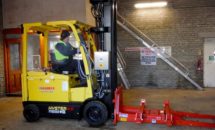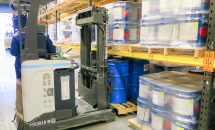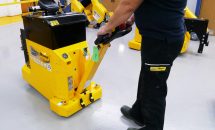ATEX compliant lift trucks used in pharmaceutical manufacturing sites have even greater safety requirements following an update to the EN1755:2015* standard in November 2017. This update is likely to affect how pharmaceutical firms, and their suppliers, manage lift trucks.
Pharmaceutical manufacturers are handling high volumes of flammable material when feeding their production process. This could be in the form of gases, flammable liquids or powders. Production and storage areas are therefore classified as hazardous zones where there is a risk of explosion.
With many different types of lift trucks essential to transport flammable ingredients, pharmaceutical companies usually specify explosion protected trucks that comply with ATEX 2014/34/EU**. EU standard EN1755 helps to achieve ATEX 2014/34/EU compliance, but has changed from November 2017. EN1755:2015 will supersede EN1755:2000. The changes to EN1755 affect pallet, stacker or reach trucks, VNA and any counterbalance trucks used in storage or production areas inside. Outdoor activities are also affected, for example in bulk storage areas where there are tanks of solvents, or waste storage areas. Waste management companies are also affected, as well as suppliers to the pharmaceutical industry.
Most of the trucks affected by this change will be used in Zone 1 or Zone 2 areas, but many are needed in Zone 21 or 22 areas where powder is the hazard. Electric trucks are typically chosen for pharmaceutical operations to ensure facilities are kept as clean as possible. “Static build up and friction can create enough energy to cause ignition, so one of the key changes to EN1755 was that static is now considered a “normal” occurrence in Zone 2 hazardous areas,” explains Rob Vesty of safety company Pyroban. “This affects the technical design of the truck and elements like tyres, seats, arm rests, cabin sides and hydraulic systems, and more.”
Pyroban’s ATEX conversions help to address the technical requirements of the updated EN1755:2015 standard, but pharmaceutical firms need to be aware of how this change may now affect their fleet day to day, as well as maintenance and parts supply. “Pharmaceutical sites could face downtime if explosion protected parts supply is not considered early enough by procurement teams or the lift truck dealer, as lead times can be longer,” says Vesty. “Many of these businesses have large fleets over numerous sites, so it could make a big difference to the operation.”
In addition to static, there are many other ways a standard forklift can be the source of ignition in a pharmaceutical application, such as a spark from unprotected electrical equipment or heat from motors, brakes and other components. EN1755:2015 now requires changes to any device or controller carrying out a safety function, which includes gas detection systems. The systems must now fulfil the requirements of PLr=C*** in accordance with EN ISO 13849-1**** or SIL 1 in accordance with EN61508-1*****.
Pyroban system6000 includes the use of gas detection, restricted breathing enclosures, stainless steel cladding for forks and surface temperature cooling to ensure the motors, brakes, electrics and other components remain below the auto-ignition temperature of the flammable materials. Usually pharmaceutical operations require T4 temperature class which is a temperature limitation of 135degC.
“system6000 a popular solution for Zone 2 applications particularly where cleanliness is important,” says Vesty. “It is a clean, simple conversion with very little added on to the exterior of the truck to compromise hygiene, and its simple to use.”
Pyroban converts all types of trucks so that they are safe and ATEX compliant. In addition to lift trucks, conversions are suitable for scrubber driers and sweepers for the production areas where cleanliness and hygiene is very important. Access platforms are also supplied for maintenance work in bigger plants. “Even in hazardous zones, pharmaceutical production lines must have high uptime,” explains Vesty. “If a truck can’t perform a particular action it can render a whole batch of product useless. This makes a proper service and maintenance regime vital.”
To ensure ongoing compliance, lift truck dealers need to make sure that engineers are fully trained and aware of the recent updates to EN1755. Approved service schedules should be followed, and approved parts should be used, which may also have been affected by the EN1755 update. Pyroban also recommends that an Ex-ASA (annual safety audit) is carried out yearly.
The recent changes to the EN1755:2015 standard apply to all materials handling equipment operating in Zone 1, 2, 21 and 22.
*‘Safety of industrial trucks. Operation in potentially explosive atmospheres. Use in flammable gas, vapour, mist and dust’
**Directive 2014/34/EU of the European Parliament and of the Council of 26 February 2014 on the harmonisation of the laws of the Member States relating to equipment and protective systems intended for use in potentially explosive atmospheres
***PLr – Determination of Required Performance Level
****EN13849 – Safety of machinery – Safety-related parts of control systems
***** EN61508-1 – Functional safety of electrical/electronic/ programmable electronic safety-related systems. General requirements
Tags:
ATEX, Ex forklift, Ex trucks, EX-truck, Hazardous areas, Pyroban, Zone 1, Zone 2
Chivas Brothers has introduced new explosion proof lift...

Kommerling UK has improved safety and productivity at i...

A company that manufactures protective woodcare coating...